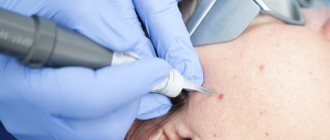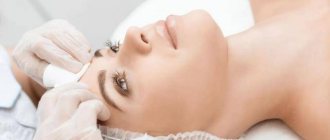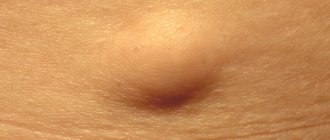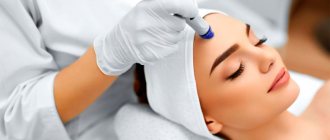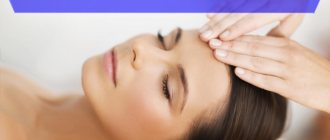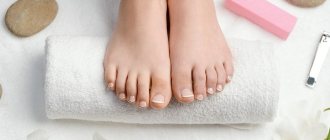Cryodestruction is a modern method of treating superficial benign neoplasms, based on cooling tissues to extremely low temperatures and their subsequent destruction. In fact, cryodestruction belongs to the field of cryosurgery and is considered a surgical treatment method.
Cryodestruction with liquid nitrogen is widely used in cosmetology, dermatology and medicine. For example, cryodestruction of warts, condylomas, papillomas and other neoplasms is popular. The procedure is widely used to treat vascular formations and cervical erosion. In many cases, it can successfully replace surgery.
The importance of caring for the growth after the removal procedure, what happens to the wound?
After the nitrogen cauterization procedure, it is necessary to understand the importance of wound care. The skin was seriously damaged. You should follow a number of certain rules, thanks to which you will minimize the occurrence of negative consequences.
Daily care will ensure faster healing of the wound. If you neglect the principles of care after cauterization, the healing process of the wound will proceed much more slowly.
After cauterization, the skin will turn red within a few minutes. The next morning, sometimes some patients develop a blister with fluid inside. The bubble should not be touched; it will go away on its own.
Methodology of the procedure
Before directly carrying out the cryodestruction procedure with liquid nitrogen, the specialist carefully examines the area of skin where the tumor has arisen. It determines the number of warts that need to be removed, their type, and size. If the wart is small, the doctor may advise not to carry out the procedure, but to postpone it for a while.
The process of removing tumors on the skin is carried out using the contact method using a special cryoapplicator device. It is cooled to a temperature of 196 degrees below zero. Under the influence of such a low temperature on the wart tissue, it dies and the cells are rejected. After this, a process of rapid skin regeneration occurs in the damaged area.
The duration of exposure of the wart to liquid nitrogen can vary from 10 to 30 seconds. Everything largely depends on the location and size it has. Liquid nitrogen evaporates after 20 seconds. Therefore, the procedure is repeated several times . During its implementation, the cryoapplicator should be in contact with the surface of the wart, as well as with the skin around it to a width of up to 1.5 mm. The effect of liquid nitrogen on the wart tissue causes it to turn white. The cryodestruction procedure is considered completed only after a white halo appears around the periphery.
How long does it take for a wound to heal?
On average, final wound healing occurs within one month. During the first week, the skin may peel and become red. If a reddish bubble appears at the site of the wound, this is not a very good sign.
This means that during the procedure, nitrogen touched the blood vessels. Recovery may take a couple of weeks longer than usual. If the bubble is white or pink, then nothing bad has happened.
Features of removing different types of warts with nitrogen
Depending on the type of wart, the following treatment features are observed:
- Flat warts are removed as follows: In a single case, nitrogen is applied to the growth with a cotton swab;
- For a large number of warts, cryomassage with nitrogen is used. To do this, nitrogen is applied to the cotton wool and the area where the formations accumulate is applied with quick circular movements;
- Most often, flat warts do not form a blister, but begin to peel off and disappear after a few weeks;
- Plantar warts are removed in several sessions, since most often such formations have deep-rooted roots;
The remaining species are removed in a classic manner and do not require special tools for applying nitrogen.
General rules for wound care, what the consequences may be, what to do when a blister appears?
Rules for caring for a wound after burning off a wart include the following:
- It is necessary to follow all recommendations of the doctor who performed the procedure.
- If you have any questions, contact the institution where the burning procedure was carried out.
- Do not block the access of fresh air to the resulting wound. It cannot be covered with adhesive tape.
- You should not be in the open sun for two weeks. Tanning in a solarium is prohibited.
- Observe basic rules of personal hygiene.
- Try not to touch the wound with your hands to avoid mechanical damage.
- Perhaps using a bit or a gauze bandage. A prerequisite is that there is no strong contact with the wound.
Combating plantar tumors
Warts on the foot may not bother a person for a long time. Pain occurs when walking when the growths grow deep into the tissue. Most often they are found on the heels, at the base of the toes and their pads.
When removing growths with liquid nitrogen, slight pain may occur, since a certain amount of pressure is required for freezing. The recovery period when treating plantar tumors takes longer. Disability can last up to 3 weeks, as it is unpleasant for a person to step on a painful area of the leg.
Plantar warts also create difficulties due to the need for frequent treatments. They are carried out 3 times every 4 days. In advanced cases, treatment can take up to six months. In order for the treatment to be of high quality, it is necessary to accurately determine the optimal depth of impact . Thanks to a careful approach, it will be possible to avoid the formation of dents and damage to healthy skin.
How to treat the affected area?
There are several stages of postoperative wound care.
- First, you need to apply an antiseptic, prescribed by your doctor, three times a day. Usually this is an antibacterial ointment Levomekol, which is excellent for wound healing. It must be applied three times a day.
- Secondly, it is recommended to apply oil solutions of vitamins A and E to the skin. They help the skin regain elasticity.
In addition to the external effect of creams and ointments, your body needs to be nourished from the inside. Complex products containing vitamins, minerals, and various microelements will contribute to a rapid recovery.
What is prohibited?
After removing a wart, it is prohibited to:
- Take hot baths and visit the sauna, especially in the first week after the procedure.
- Remove the crust from the wound yourself. This can lead to the addition of another infection and the occurrence of an inflammatory process.
- Apply various cosmetics to the wound. You should not use foundation, concealer, or powder to disguise the wound.
- Contact with any detergents. This will lead to inflammation in the wound area. If the removal took place on the palms, it is imperative to wear rubber gloves when washing dishes.
- Visit the pool and water park. Chlorinated water will irritate the wound.
Who is contraindicated for cryodestruction?
Best materials of the month
- Why you can't go on a diet on your own
- 21 tips on how to avoid buying stale food
- How to keep vegetables and fruits fresh: simple tricks
- How to curb your sweet cravings: 7 unexpected products
- Scientists say youth can be extended
Removal of keratomas with liquid nitrogen is considered a method that has the fewest contraindications among all methods of removing benign skin lesions. However, in some cases this procedure is still excluded.
Thus, there is the concept of “cold allergy” - individual hypersensitivity to low temperatures, which manifests itself in the form of an allergic reaction. Symptoms of a cold allergy are redness of the skin exposed to cold, severe itching and burning, and the appearance of hives. Of course, those who suffer from such allergies should not undergo cryodestruction of the keratoma.
Couperosis, a vascular “mesh”, is also a contraindication. The procedure should be temporarily postponed if the body temperature rises, as well as if the patient has recently suffered from a cold or infectious disease. You should also approach the procedure with caution if the patient suffers from diseases of the cardiovascular system.
Possible complications and treatment methods
Unfortunately, after removing a wart with liquid nitrogen, some complications may arise.
What to do if it swells and a blister appears?
After the procedure, a blister may form at the site of the wart. There is no need to worry or panic.
This option is considered the norm. The most important thing is to process it very carefully and not to injure the bubble that appears. It is necessary to treat the area with salicylic alcohol for 7–10 days.
After treatment, you need to smear the area with any moisturizer. It is recommended to carry out this treatment 2 times a day. Opening the bubble yourself is strictly prohibited.
It will open on its own within two weeks. If the blister increases in size and causes significant discomfort, you should consult a doctor. You may need to take a course of antibiotics.
Wound suppuration
This kind of complication is rare. A wound that has not yet healed may experience pain and discharge of pus. If this cannot be avoided, you should definitely consult a doctor. Treating a purulent wound without medical advice can be very dangerous.
In such cases, wound treatment with furatsilin, potassium permanganate or hydrogen peroxide is prescribed. When the wound suppurates, the inflammatory process begins and surgical intervention may be required.
Reviews
Cryodestruction is used to treat warts in a large number of patients. All of them leave their reviews mostly positive.
Patients claim that treatment of neoplasms is as comfortable as possible for them, since it does not require special training or a rehabilitation period.
Patients say that with the help of cryodestruction they were able to get rid of warts once and for all. They say in their reviews that cryodestruction is more effective than drug therapy. The procedure very rarely leads to complications.
A pigment spot appeared at the site of the growth
If you have sensitive skin, then there is a risk of developing a pigment spot. Pigmentation can also appear if a person does not follow the rules of care and exposes the wound to direct sunlight.
Usually the spots go away within one month. In exceptional cases, it may remain on the skin. But over time, it will gradually lighten and perhaps go away, or remain barely noticeable.
The growth appeared again
It must be remembered that by removing the wart, you have not solved the problem as a whole. After all, if this kind of neoplasm appears on your skin, it means that HPV is present in the body.
To suppress the activity of this virus, complex therapy is necessary, which includes taking antiviral drugs and increasing human immunity.
Important!
You should be attentive to any complications that arise during the postoperative period. It must be remembered that warts can very easily develop into malignant neoplasms. Therefore, be careful and monitor the condition of the wound after removal.
Removing warts at home
You can also burn off warts at home using cryotherapy. To do this, you just need to buy a special drug at the pharmacy, which is similar in effect to liquid nitrogen.
Such drugs include:
- Cryopharma - not liquid nitrogen is used as a refrigerant, but a specially created chemical compound. The disadvantage of this drug is the lack of a deep effect on the tissue, so it can only be used for superficial warts. The average price of the drug is from 500 rubles ;
- Wartner Cryo - the freezing temperature of this drug is about 60 °C, so the risk of side effects when using pharmaceuticals is small. The average price of the drug is from 700 rubles .
Cryopharma
Wartner Cryo
Products can only be used after consultation with a doctor, and strictly following the instructions for use.
Contraindications for self-freezing warts are:
- Pregnancy and breastfeeding;
- Diabetes;
- Age up to 4 years;
- Growths on the mucous membranes.
